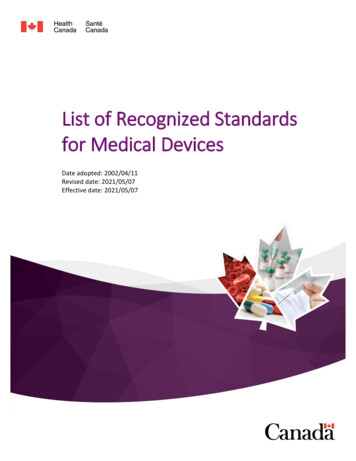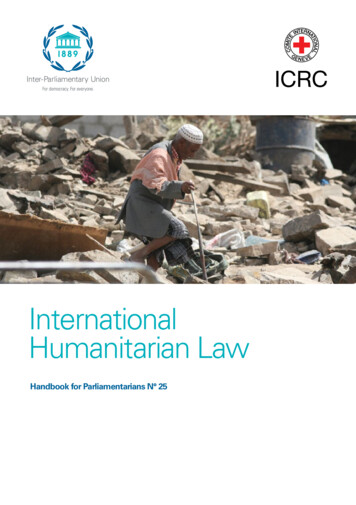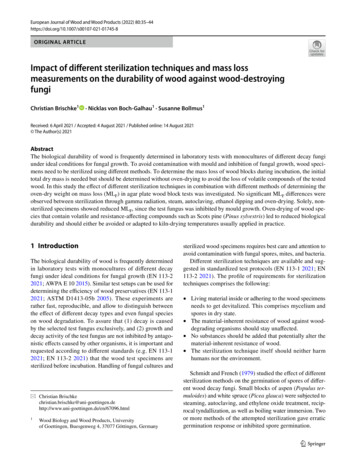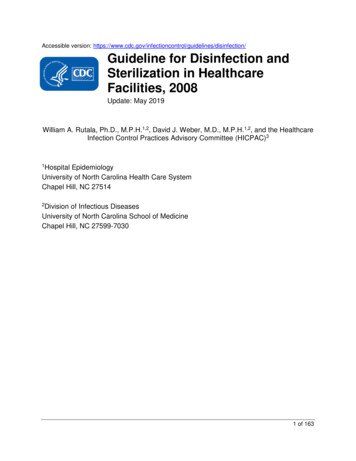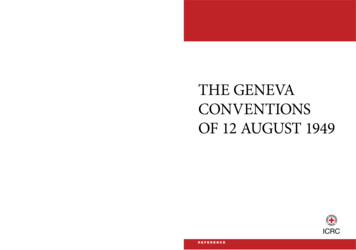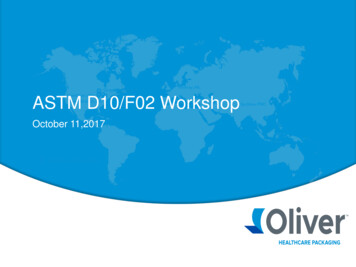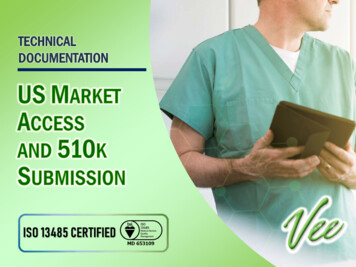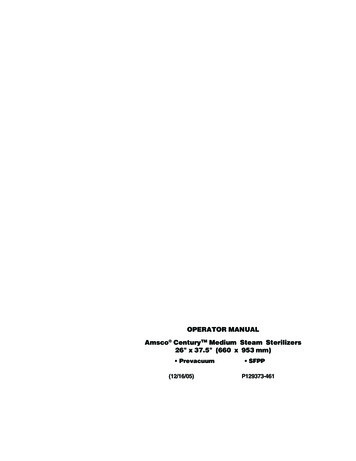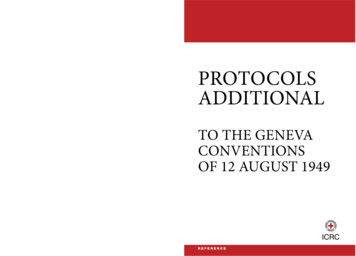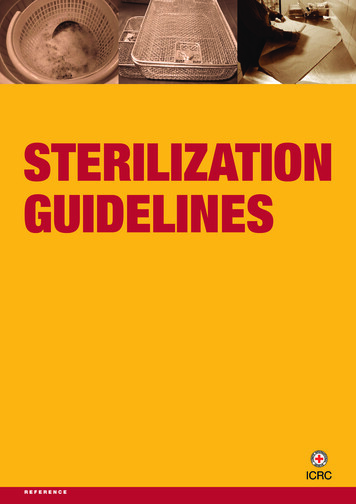
Transcription
STERILIZATIONGUIDELINES
International Committee of the Red Cross19, avenue de la Paix1202 Geneva, SwitzerlandT 41 22 734 60 01 F 41 22 733 20 57E‑mail: shop@icrc.org www.icrc.org ICRC, December 2014Cover photos: Julie Barnet/ICRC, Reda instruments, Jeannette de Vries/ICRC
STERILIZATIONGUIDELINES
STERILIZATION GUIDELINES3TABLE OF CONTENTS1.Terms and General information85.Principles of contamination5.1. Methods of reducing the bioburden10116.Classification of instruments (Spaulding Classification)127.Organizing the sterilization department7.1. The flow of instruments through the central sterile supplies department7.1.1. The cleaning (or dirty) zone7.1.2. The packaging (or clean) zone7.1.3. The autoclaving (or sterile) zone7.1.4. The storage and distribution zone1314141415158.Water and electricity needs169.The sterilization cycle9.1. Collection9.2. Pre‑disinfection9.3. Cleaning, disinfection and drying9.4. Checking to ensure instruments are and remain intact9.5. Packaging9.5.1. Two types of paper9.5.2. American folding technique9.6. Saturated steam sterilization – the autoclave9.6.1. General information9.6.2. The steam sterilization cycle9.6.3. Sterilization cycle temperature9.6.4. Safety9.7. Control9.7.1. Checking the sterilization cycle9.7.1.1. Chemical indicators TST STRIP9.7.1.2. External indicator Tape9.7.1.3. Checking the package is undamaged at the end of the cycle upon unloading171718191920202121212222222323232424
4STERILIZATION GUIDELINES9.8.Autoclave with vacuum pump9.8.1. Checking the airtight seal before sterilization Bowie‑Dick test9.8.2. Reading the graph for a vacuum‑pump autoclave9.9. Traceability9.10. Storage9.10.1. Expiry9.10.2. Checking9.10.3. Stock management242425262627272710.Emergency sterilization10.1. Operating with instruments sterilized using the emergency procedure10.2. “Emergency” readiness28282811.Sterilization procedure for linen11.1. Organizing a laundry11.2. Collection11.3. Procedure for washing linen11.3.1. Washing by hand11.3.2. Machine washing11.4. Packaging, sterilization and storage2929303030313112.References32ANNEX I – Instructions for folding a surgical gown33ANNEX II – Summary procedure for pre‑disinfecting and disinfecting instruments34ANNEX III – HEXANIOS PROTOCOL (Technical File)36ANNEX IV – SURFANIOS PROTOCOL (Technical File)37ANNEX V – Top‑loading vertical autoclave without vacuum pump (e.g. TBM 90-litre)39ANNEX VI – Front‑loading horizontal autoclave with vacuum pump (with or without steam generator,e.g. Matachana SC 500)40ANNEX VII – Operating instructions for the TBM 90-litre autoclave41ANNEX VIII – Operationing instructions for the 45-litre autoclave44ANNEX IX – Operating instructions for the 39-litre autoclave45
STERILIZATION GUIDELINES1.TERMS AND ngContaminationDisinfectionHigh‑level disinfectionHIVFree from disease‑causing contaminantsThe number of viable micro organisms in or on an object entering a sterilization processA thin, usually resistant layer of micro organisms (e.g. bacteria) that forms on and coatsvarious surfacesEuropean Committee for StandardizationVisual inspection and manual testing to ensure instruments are intact and perform properlyConsists of removing organic and non‑organic substances through the physical‑chemicalaction of a detergent combined with a brushing and rinsing actionThe presence of a minor and unwanted constituent (contaminant) on a material or in aphysical bodyThe use of disinfectant solution to destroy or prevent the growth of organisms capable of infectionThe elimination of vegetative forms of bacteria and viruses by immersing pre‑disinfected andcleaned instruments in a disinfectant solution; used for semi‑critical materials that cannottolerate steam sterilizationHuman Immunodeficiency VirusICRCInternational Committee of the Red CrossISOInternational Standardization OrganizationMedical deviceMicrobicidalPackagingPathogenAny medical equipment used on a patient for the purpose of preventing, detecting,diagnosing or treating a pathologyDestroying or reducing the infectivity of microbes such as viruses and bacteriaProtecting clean instruments from the risk of re‑contamination during handling and aftersterilization in order to keep them sterile and protected until they are usedA bacterium, virus or other micro organism that can cause diseaseSterileA medical device is considered sterile and referred to as “sterile” if the possibility that it hasbeen contaminated by viable micro organisms is equal to or less than one in a million (CENand ISO standards).SterilizationA process that destroys all micro organisms (including bacterial spores) on the surface of anobject or in a fluidTBWHOTuberculosisWorld Health Organization5
6STERILIZATION GUIDELINES2.INTRODUCTIONAll hospitals need to sterilize their equipment and supplies. Even the smallesthospital requires sterile surgical instruments for minor procedures, and steriledressing materials. If a hospital has a full surgical unit, the sterilization of surgicalinstruments and linen, together with dressing materials for the wards and operatingtheatre, plays a key role in infection control.In medical facilities supported by the ICRC, care must therefore be taken to providesafe, sterile surgical material and safe blood for transfusion. This is all the moreimportant when the ICRC is working in a general hospital setting where elective orsemi‑elective surgery is a routine part of the workload.Processing potentially infected materials also presents a hazard to medical staff.The procedures for cleaning and disinfecting these materials should thereforeinclude protective measures for those who handle them. Correct handling and safeprocessing of surgical materials are part of the standard precautions that should betaken in any medical facility, including those supported by the ICRC.In 2004 a workshop was held for experienced ICRC operating theatre (OT) nursesand experts from Médecins Sans Frontières to discuss the main problems relatingto sterilization in the context of humanitarian operations. This workshop led to thedrafting of the first edition of the Sterilization Guidelines.Ten years later, it was time to review the Guidelines in light of recent scientificdiscoveries, new sterilization procedures and technological developments.While the systems and procedures outlined in the Guidelines may be difficult to fullyimplement in all ICRC‑supported medical facilities, they represent good practiceand set the standard to achieve in order to ensure a basic level of safety. This willsometimes involve an investment in infrastructure, equipment and training, all ofwhich requires planning and budgeting.The Guidelines are intended for use by OT nurses working in ICRC‑supported medicalfacilities. While they do not cover all aspects of infection control and sterilizationin detail (for more information, see the publications selected as resource materialunder “Reference”), they should help OT nurses in various hospitals, facing differentchallenges, to set up safe and simple systems for processing the entire range ofsurgical materials requiring sterilization.The Guidelines can be applied in situations where resources are limited and may beused to provide essential training for OT nurses and for anyone involved in sterilization.
STERILIZATION GUIDELINES3.ACKNOWLEDGEMENTSI would like to express my deepest gratitude to all the people who helped andsupported me throughout the process of reviewing the Sterilization Guidelines.My special thanks go to the author of the first edition of the Guidelines, JennyHayward‑Karlsson, on whose excellent work the present update is based.I also take this opportunity to thank those who helped review and correct the newGuidelines, without whose professional support the undertaking would have beenimpossible. I am particularly indebted to Julie Barnet, who initiated the project andwrote the first draft. I am also very grateful to Mr Hervé Ney, head of the SterilizationDepartment at the University Hospital in Geneva, for his technical advice andsupport, which were of great help.A special mention goes to Catherine O’Shea, who provided continuous support andexpert advice throughout the review process.To all of you, I extend my most sincere thanks.Jeannette de Vries7
8STERILIZATION GUIDELINES4.GENERAL INFORMATIONThis document establishes guidelines for the effective use of steam sterilizers(autoclaves), the decontamination of cultures and other materials, the preparationof sterile supplies and the safe operation of autoclaves.Cleaning, disinfection and sterilization are key to preventing the spread ofinfections. In spite of this, many health-care facilities either lack the means toperform basic infection, prevention and control tasks or their personnel receiveinsufficient training.Every hospital must have the means to sterilize equipment and supplies. Eventhe smallest health facility will need sterile surgical instruments for minor surgicalprocedures and sterile dressing material. The sterilization department must be ableto provide the operating theatre and wards with a sufficient quantity of sterile itemsfor routine and emergency work.In the health facilities the ICRC supports, it has a responsibility to provide safe andsterile surgical material. As stated in ICRC Assistance Policy Doctrine 49, biosecurityis of prime importance. The main micro organisms of concern are HIV, TB, hepatitisB and C, staphylococcus and bacterial spores. Biosecurity is an important hospitalfunction and calls for trained essential staff.The aim of sterilization is to treat medical supplies in such a way that they can beused safely without unnecessarily endangering the patient or the user. To ensurethat equipment and materials are safely sterilized, it is essential for the person usingthem to be well trained and for the autoclave to be in perfect condition.While the systems and procedures outlined in these guidelines may be difficult toachieve in all health facilities in which the ICRC is present, they nevertheless representbest practices ensuring a basic level of safety. This should be an achievable goal inany ICRC‑supported health facility provided investment in essential infrastructureis planned and budgeted.All changes and adaptations to the 2005 edition of these guidelines are basedon WHO, CEN and ISO norms relating to patient safety and control of healthcare‑associated infections. Their aim is to ensure good quality care and safety forICRC patients and health staff.Health staff in charge of sterilization need to have a thorough knowledge of:zz the nature of the organisms that cause infection;zz the measures taken to limit the spread of disease;
STERILIZATION GUIDELINEShow disease‑causing organisms can be destroyed;how to use sterilization equipment safely and successfully;the design and operation of sterilization equipment;all types of loads and packaging systems and their behaviour when exposedto steam;zz the methods for checking the performance of sterilizers.zzzzzzzz9
10STERILIZATION GUIDELINES5.PRINCIPLES OF CONTAMINATIONA body penetrated by disease‑causing micro organisms is said to be “contaminated”.Instruments used during an operation are also considered to be contaminated by thepatient’s micro organisms and pathogens. If these instruments are not scrupulouslycleaned and sterilized before being used on another patient, pathogens can bepassed from one patient to another.The population of viable organisms on materials, instruments, linen, etc., is referredto as the “bioburden”, or initial contamination.Hospital‑acquired or nosocomial infections are infections that patients acquireduring their stay or treatment at a hospital or health centre. Such infections areeasily transmitted during daily hospital practice:zz if the instruments used during surgery are not free of micro organisms;zz if staff do not wash their hands properly before and after treating patients;zz if the material used to treat wounds is not free of micro organisms;zz if contaminated waste is not disposed of properly (see the ICRC publicationMedical Waste Management);zz if food is contaminated.Cross‑infections are infections transmitted from one patient to another throughcontaminated equipment, instruments and materials. Cross‑infection is one of themajor causes of nosocomial diseases. It has a huge impact on the patient:zz extended stay in hospital leading to more nursing care, more operations andmore rehabilitation;zz increased health complications that can ultimately result in death.For health-care providers, the extra costs can lead to a rise of up to 10 per cent inthe hospital “budget”.1It is essential for health staff to understand the mechanisms by which infectionis transmitted and correct microbicidal processes so that ICRC‑supported healthfacilities can provide good‑quality health care to those who need it.1WHO, Hospital Infection Prevalence Survey, June 1987.
STERILIZATION GUIDELINES5.1.Methods of reducing the bioburdenSterilizationDisinfectionCleaningDirt and soilsMicroorganismsSporesFigure 1 Methods of reducing the bioburdenCleaningThe process of removing dirt and soils, but not killing micro organisms and spores.DisinfectionThe process of destroying all pathogenic micro organisms, but not bacterial spores.SterilizationThe process of destroying all forms of microbial life on inanimate surfaces, includingbacterial spores.11
12STERILIZATION GUIDELINES6.CLASSIFICATION OF INSTRUMENTS(SPAULDING CLASSIFICATION)In 1968, Dr E. H. Spaulding classified medical/surgical instruments as critical,semi‑critical and non‑critical based on their potential to spread infections. Theclassification helps to decide how to proceed with the instruments.Critical itemsItems that penetrate soft tissue, bone or the vascularsystem, or through which blood flows, such asimplanted medical devices, which should be sterilewhen used.Semi‑critical itemsObjects that touch mucous membranes or non‑intactskin, such as endoscopes and respiratory therapyequipment, and which require high‑level disinfection(elimination of all micro organisms except highnumbers of bacterial spores).Non‑critical itemsObjects that are in contact with intact skin, such asbedpans, blood pressure cuffs and bedside tables.Low‑level disinfection is required. These items are lesslikely to spread infections, except when contaminatedwith pathogens by the hands of health-care personnel.They require rigorous cleaning, washing anddisinfection, and hands must be washed after handlingthem.Figure 2 Spaulding Classification
STERILIZATION GUIDELINES7.ORGANIZING THE STERILIZATION DEPARTMENTBefore an instrument can be used, a whole range of measures must be taken toprevent it from being a danger to the patient. Sterilization is only one link in thechain of activities required to make an instrument sterile at the moment of use.Each link involves specific methods and techniques that prevent contamination ofinstruments, materials and living tissue. This is called the aseptic technique and isdesigned to prevent contamination of instruments, materials and living tissue. Itincludes, for example, covering the patient during the operation with sterile drapes,cleaning the operating table, and cleaning and decontaminating the patient’s skinwith iodine before starting the operation.The aseptic technique must also be followed in the sterilization department.Hospitals in the developed world employ various methods of organizing the entireinstrument sterilization process (collection, pre‑disinfection, cleaning, disinfection,packaging, sterilizing, distributing and storage). In the field, this task may not existor may be carried out by a specialized department that may not even be in the samepremises as the health facility.In ICRC‑supported hospitals that have a surgical department, the preferred option isto set up a central sterile supplies department. Within this department, all surfaces(walls, floors, ceilings, shelves) should be washable. All rooms should be wellventilated and lit. In a challenging environment (dust, flies, damaged infrastructureor extreme heat/cold), a balance has to be struck between adequate light andventilation and the potential for contamination of clean material. An uninterruptedsupply of water and electricity is essential.13
14STERILIZATION GUIDELINES7.1.The flow of instruments through the central sterile distributionzoneThe cleaning (or dirty) zoneThis is the area in which reusable instruments are collected, registered, cleaned anddried. These activities can all be carried out in the same room, provided that all stepsare carried out in one direction only and that nothing ever moves back towardsthe dirty zone – dirty and clean items must never cross.The dirty zone should be laid out in a way that facilitates this flow. In some settings,a wall will separate the dirty zone from the clean zone, although the two have tobe connected via a doorway (or a wicket) to facilitate the transfer of instruments.All items must be checked to ensure they have been properly cleaned before theyleave the dirty zone, and before being dried and packaged. Any items that are notproperly clean must be recleaned before they can leave the dirty zone. The dirty zone should be easily accessible from the operating, obstetric and surgicalemergency departments to facilitate the reception of reusable instruments. It must alsobe located next to the clean oneThe packaging (or clean) zoneThis is the area for checking/inspecting instruments, reassembling instrument sets,high‑level disinfection, packaging and storage of packages ready to be sterilized.Damaged instruments should be set aside for the attention of the senior nurse.The clean zone should be separated from the dirty zone by a wall, with a door (or awicket) connecting them to facilitate the transfer of material. It should be located between the dirty zone and the sterile zone.
STERILIZATION tionzoneThe autoclaving (or sterile) zoneThis is the area in which the instruments ready to be sterilized by steam sterilizationin an autoclave are registered. The appropriate heating source for the autoclave isdefined with the technical resource person (trained hospital technician). The choicebetween electricity/gas/kerosene will depend on the type of autoclave, the levelof the health facility and the availability of electricity/fuel; this should be discussedwith the WatHab engineer and, if one is available, an ICRC biomedical engineer. It is important to ensure that there is enough space on all sides of the autoclavefor safe use and maintenance. TBM 90 l autoclaves should be at least 0.60 m fromother equipment and adjacent walls. A steam exit has to be provided in line with themanufacturer’s specifications (this is usually created through an exterior wall, withaccess to the exterior area, so that people will not be scalded by escaping steam). Thisaccess must be restricted to qualified personnel to prevent ionzoneThe storage and distribution zoneThis is the area in which sterile packages are stored until distributed. It is importantto have a storage place in which instruments and sterile items are protected fromthe risk of recontamination, i.e. dust, insects, damage to packages, humidity, light,and in which their sterile status is maintained until they are used. It should be located next to the autoclaving zone, in a separate room.15
16STERILIZATION GUIDELINES8.WATER AND ELECTRICITY NEEDSThe average amount of water needed in the sterilization room exclusively (notincluding activities in the operating theatre) is set out below.2Pre‑disinfection, disinfection, rinsing and cleaning of instruments:zz 100 l / operation (entire instrument load for any kind of surgery)zz 30 l / delivery (all instruments for a non‑surgical delivery)zz 30 l / 5 dressings or 5 suturesAutoclave:zz 48 l / TBM 90 l autoclave cyclezz 8‑16 l / 45 l autoclave cycleHigh‑level disinfection:zz 35 l / procedureCleaning / disinfection of the room and staff hand hygiene:zz 30 l / day minimumFor info:zz Water supply needed in the operating department: 100 l / surgicaloperationImportant:zz The water for the autoclave drying cycle must be cold ( 25 C if possible).zz Water hardness: should be soft to avoid limescalezz Water consumption, temperature and pressure for larger autoclaves areaccording to manufacturer specifications (e.g. Matachana, Getinge, Cisa).Consult with the biomedical engineer in Geneva before installing these typesof autoclaves.See P. Perrin, H.E.L.P. Public health course in the management of humanitarian aid, ICRC, Geneva,2001.2
STERILIZATION GUIDELINES9.THE STERILIZATION CYCLEPreventing the spread of infection: Move in one direction only. Never movebackwards. Never cross clean and soiled instruments.9.1.CollectionFigure 3 Perforated basketsWhysafe collectionless handling of soiled instrumentseasy and safe transport to the sterilization roomless mixing up of surgical setseasier and quicker pre‑disinfectioneasily available and inexpensive on local marketszzzzzzzzzzzzAimTo ensure staff safety and minimize the risk of spreading micro organisms in theenvironment. Medical devices should be collected and pre‑disinfected as soon aspossible after use. In the operating theatre, instruments must be sent for cleaningafter each operation. On the wards, they should be collected at least twice a day.This is to avoid blood and secretions drying onto the instruments.Julie Barnet/ICRCJulie Barnet/ICRCJulie Barnet/ICRCUse perforated baskets placed in closed containers.17
18STERILIZATION GUIDELINES9.2.Pre‑disinfectionAimTo reduce of the number of micro organisms on the surface of the equipment, thusreducing the risk of contamination and ensuring the safety of staff handling theequipment.Procedure (HEXANIOS 0.5%) Laboratoires Anios(Microbiological properties: see Annex III)Instructions for use: concentrated solution to be diluted at 0.5% before use 1 stroke (25 ml) of the dosing pump for 5 l water 2 strokes (50 ml) of the dosing pump for 10 l waterHowzz Prepare a soaking bath/solution according to the volume of medicalCode:XLABALAR60MAlarm clock, analog, 1 mn‑60 mn, pceJulie Barnet/ICRCinstruments (5 or 10 l).zz Immerse the instruments completely in the soaking bath and leave them tosoak for 15 minutes (using a timer).zz Rinse with clean water.Figure 4Alarm clockInstruments and equipment should be pre‑disinfected and cleaned assoon as possible after use to prevent the formation of a biofilm.Throw the used solution away. Prepare a fresh bath for each load.
STERILIZATION GUIDELINES9.3.Cleaning, disinfection and dryingAimElimination of blood, secretions and debris via the chemical action of a detergent(Hexanios ) combined with the mechanical action of brushing and rinsing. All itemsmust be carefully cleaned before sterilization.Instruments and equipment must be thoroughly cleaned and disinfected,otherwise the sterilization process will not be effective.Procedure: HEXANIOS 0.5%Instructions for use: concentrated solution to be diluted at 0.5% before use 1 stroke (25 ml) of the dosing pump for 5 l water 2 strokes (50 ml) of the dosing pump for 10 l waterHowzz Prepare a soaking bath/solution according to the volume of medicalinstruments (5 or 10 l).zz Immerse the instruments completely in the soaking bath, scrub themthoroughly and leave them to soak in the solution for 15 minutes. Rinsethoroughly with clear water, discard the rinsing water and dry with a cleancotton cloth.This solution can be kept for a maximum of 24 hours. Prepare a freshbath immediately if it is visibly contaminated (dirty).9.4.Checking to ensure instruments are and remain intactMedical instruments are expensive precision instruments. Small deposits of bloodmay easily develop into serious corrosion (rust). This corrosion is aggravated bythe moisture and high temperatures of the sterilization process. Corrosion willresult in serious damage to the instruments and may even render them uselessand dangerous for the patient. This is why every instrument should be checkedcarefully before being packed. If it is damaged or no longer functioning, alert thesenior nurse so that the instrument can be exchanged.Figure 5 Checking the instrumentsJulie Barnet/ICRCJeannette de Vries/ICRCJeannette de Vries/ICRCApply oil if necessary, but use only specific silicone‑free instrument oil, which allowssteam to penetrate during sterilization. The instrument should be rinsed to removeexcess oil and dried.19
20STERILIZATION GUIDELINES9.5.PackagingAimzz Before sterilization: packaging protects the clean instruments from the risk ofcontamination.zz Packaging must allow the packages to be opened easily and aseptically.zz Packaging must be permeable to steam, water repellent, resistant to tears andimpermeable to micro organisms.zz After sterilization: packaging must keep the instruments sterile until they are used.9.5.1.Two types of paperNon‑woven paperInstruments are packed in wire baskets wrapped in two layers of non‑woven paper(stronger than crepe paper). Baskets should be wrapped with single sheets, twice.Crepe PaperUse crepe paper for single instruments, diathermy devices, dressing sets andcompresses (in groups of 10‑20 compresses, as drums are no longer recommended).ProcedureThe paper used must be at least 3 or 4 times the size of the total material to bepacked (in both width and length).Once the paper has been autoclaved, it cannot be re‑autoclaved. The filters in thepaper are closed by the first sterilization and are therefore not re‑autoclavable.Use the American square or envelope folding technique for both layers.Code:XSTEBASK201Basket, Sterilizing, 201x145x50 mm plus lidXSTEBASK402Basket, Sterilizing, 380x240x90 mm plus lidXSTEBASK502Basket, Sterilizing, 480x240x90 mm plus lidXSTEBASK302Basket, Sterilizing, 300x200x35 mm plus lidMSTESTSHNW120Sheet Sterilisation /‑ 60 gr/m2, 120x120cm non wovenJeannette de Vries/ICRCReda instrumentsJeannette de Vries/ICRCClose the package carefully using sterilization tape.Figure 6 Baskets wrapped in two layers of non‑woven paper
STERILIZATION GUIDELINES9.5.2.American folding technique123456789Figure 7 American folding technique9.6.Saturated steam sterilization – the autoclave9.6.1.General informationThe sterilization of materials using steam and pressure is a reliable method ofdestroying all forms of microbial life. However, the autoclave must be properlyused and understood to be effective. The technique/steps recommended by themanufacturer must be followed exactly, otherwise the sterilization process will beincomplete (see Annexes V, VI, VII and VIII).zz An autoclave is basically a large pressure cooker; it operates using steam underzzzzzzzzpressure as the sterilizing agent. The high pressure heats the steam to hightemperatures, thus increasing its heat content and killing power.Steam is able to penetrate objects with cooler temperatures because oncethe steam contacts a cooler surface, it immediately condenses to water. Thiscreates negative pressure at the point of condensation and draws more steamto the area. Condensation continues as long as the condensing surface iscooler than the steam; once both are the same temperature, a saturated steamenvironment is formed.Achieving a high and even moisture content in the steam‑air environmentis important for effective autoclaving. Steam also efficiently kills cells andcoagulates proteins.Moist heat is thought to kill micro organisms by causing coagulation ofessential proteins.The micro organism dies because of an accumulation of irreversible damageto all its metabolic functions.21
22STERILIZATION GUIDELINES9.6.2.The steam sterilization cycleThe steam sterilization cycle consists of various .2.3.4.5.6.7.8.9.Pre-vacuum Cycle PhasesStart – door seals, jacket warmschamberPurge – steam enters chamber,while air is purged through thechamber drainConditioning – positive pressureand negative vacuum pulsescontinue to heat load and purgeairHeat up – steam pressure buildsto selected exposure temperatureand pressureExposure – timing begins forselected exposure time andtemperatureExhaust – chamber drain opensand ejector water creates vacuumin chamber to exhaust steamDrying – ejector water controlsvacuum in chamber for selecteddry timeAir in – chamber returns toatmospheric pressureCycle complete – door can beopened ExposureTime DryingTimeFigure 8 The steam sterilization cycle9.6.3.Sterilization cycle temperatureAll surgical instruments and linen used for major surgeryChoice 1: 134 C at 2.1 bars for 18 minutes3(134 C 2.1 bars in relative pressure; 3.1 bars in absolute pressure;and 0.985 bars in atmospheric pressure)9.6.4.SafetyBecause autoclaves use steam, heat and pressure, the risk of individual exposureand accident is high. Personnel should wear proper personal protective equipment,i.e. heat‑resistant gloves, eye protection and a lab coat, particularly when unloadingthe autoclave.Do not assume that the temperature and pressure have fallen when opening thechamber. Even if the pressure gauge shows “0”, open the chamber carefully; start byopening the door just a crack to allow steam to dissipate (don’t fling the door open,as steam might billow out and scald you).After opening the door, leave the items inside for five minutes before handling. Thiswill reduce the risk of boil‑over and scalding.Regularly inspect the autoclave to make sure it is working properly. Have a trainedhospital technic
If a hospital has a full surgical unit, the sterilization of surgical instruments and linen, together with dressing materials for the wards and operating theatre, plays a key role in infection control. In medical facilities supported by the ICRC, care must therefore be taken to provide safe, sterile s
